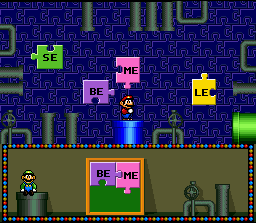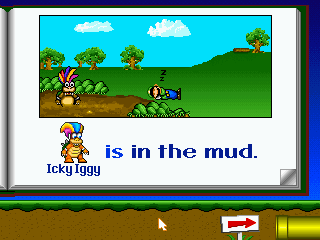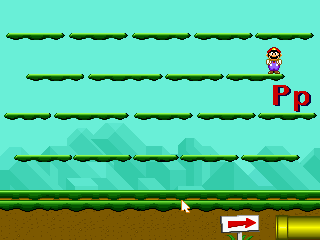Retro Replay Review
Gameplay
Mario’s Early Years: Fun With Letters delivers a diverse set of letter-based activities that keep young learners engaged through familiar characters and structured challenges. Players choose between Mario or Princess Toadstool as their guide, then explore ten distinct “worlds,” each dedicated to a specific literacy skill. These worlds cover letter recognition, vowel identification, letter-sound matching, sentence completion, and more—ensuring that children encounter a full spectrum of early reading tasks.
The game offers two modes to suit different learning styles. In Discovery mode, kids are free to explore the activities at their own pace, experimenting with letters and sounds without constraints. This open-ended approach fosters curiosity and allows players to revisit favorite exercises. In Learning mode, Luigi steps in as a tutor, guiding children through step-by-step instructions and offering feedback. This structured path helps reinforce concepts and build confidence in letter-sound correspondence.
Each activity features simple controls optimized for young hands: point-and-click interactions, drag-and-drop letter matching, and audio prompts that encourage auditory learning. Activities automatically adjust in difficulty based on the child’s performance, ensuring that tasks remain challenging but not frustrating. This adaptive design keeps beginners from feeling overwhelmed and encourages steady progress.
Parents can also customize the gameplay experience through difficulty settings, time limits, and activity selection, tailoring lessons to each child’s pace. The built-in Parent’s Information Center further enhances gameplay by outlining educational objectives, offering extension ideas, and providing printable worksheets. This holistic approach ensures that screen time translates to meaningful learning outcomes.
Graphics
The visuals in Mario’s Early Years: Fun With Letters are bright, colorful, and immediately appealing to children ages 3 to 6. Backgrounds feature familiar Mushroom Kingdom motifs—rolling green hills, blue skies, and iconic question-mark blocks—creating a playful environment that resonates with fans of the Mario universe. Each activity screen is clearly laid out, with bold icons and large letters that are easy for small eyes to distinguish.
Character animations are simple yet expressive. Mario, Princess Toadstool, and Luigi perform cheerful gestures and enthusiastic reactions when players select correct letters or complete a challenge. These animations provide positive reinforcement, turning each success into a mini celebration. Sound effects—such as coin jingles and character exclamations—also contribute to the experience without overwhelming young learners.
The user interface prioritizes clarity and consistency. Menus use large buttons labeled with pictures and text, ensuring non-readers can navigate the game with minimal adult assistance. Letter shapes and colors are uniform across activities to reduce confusion, and high-contrast text helps struggling viewers. Overall, the graphical presentation balances fun aesthetics with educational clarity.
Though the graphics aren’t technically advanced compared to modern titles, they suit the game’s educational purpose. The emphasis on legibility, consistent color-coding, and recognizable characters means children can focus on learning letters rather than complex visuals. For its target age group, the art style effectively combines charm and function.
Story
Unlike narrative-driven platformers, Mario’s Early Years: Fun With Letters uses a light framing story to motivate young players rather than a deep plot. Mario and Princess Toadstool invite children on a letter-learning adventure throughout the Mushroom Kingdom. This simple premise provides context for each activity and connects the educational tasks to characters the child already knows and loves.
Luigi’s role in Learning mode adds a playful “mentor” storyline: he appears in cutscenes to introduce new worlds, offer hints, and celebrate successes alongside the player. These brief interludes give structure to the learning journey, mimicking a teacher-student dynamic. As each world is completed, children feel a sense of progression, as if journeying through the kingdom one lesson at a time.
The story-driven moments are concise, ensuring that narrative elements enhance rather than distract from the core educational content. Occasional supportive dialogue from the characters creates a friendly atmosphere that encourages kids to try again if they make mistakes. This nonpunitive storytelling approach builds confidence and reduces anxiety around learning new letters and sounds.
While fans of traditional Mario adventures might miss platforming or villain confrontations, the light narrative in this title is perfectly suited to its educational aim. The familiar faces and gentle encouragement provide enough context to make each letter activity feel like part of a fun-filled journey.
Overall Experience
Mario’s Early Years: Fun With Letters excels as an introductory literacy tool for preschoolers and kindergarteners. Its blend of open-ended exploration and guided learning caters to a range of young skill levels, allowing children to build foundational reading abilities at their own pace. The game’s adaptive difficulty and positive reinforcement keep motivation high, transforming screen time into constructive learning sessions.
The inclusion of a Parent’s Information Center is a standout feature. It demystifies each activity’s educational goals and suggests real-world extensions—like practicing letters with refrigerator magnets or going on a letter scavenger hunt. This integration of digital and hands-on learning ensures that parents can reinforce concepts beyond the console, creating a well-rounded educational approach.
Accessibility features—such as large text, consistent iconography, and audio prompts—allow children with varying abilities to participate fully. Parents can tailor settings to address specific learning needs, making the game versatile for different home and classroom environments. The game’s pacing respects young attention spans, with short, varied activities that prevent boredom.
Overall, Mario’s Early Years: Fun With Letters offers an engaging, child-friendly package that balances educational rigor with the joyful spirit of the Mushroom Kingdom. Its combination of beloved characters, clear visuals, and thoughtfully designed activities makes it an excellent choice for parents seeking interactive literacy tools. Whether used at home or in early learning classrooms, this title delivers a fun, effective introduction to letters and reading.
 Retro Replay Retro Replay gaming reviews, news, emulation, geek stuff and more!
Retro Replay Retro Replay gaming reviews, news, emulation, geek stuff and more!









Reviews
There are no reviews yet.